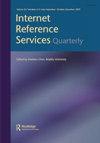Online Instruction during the COVID-19 Pandemic: Inclusivity, Accessibility, Challenges, and Opportunities
Q3 Social Sciences
引用次数: 6
Abstract
In the uniquely fraught 2020–2021 academic year, the Instruction Committee of the Consortium of Academic and Research Libraries in Illinois (CARLI) hosted two online discussions for members regarding how the COVID-19 pandemic had affected their teaching experiences. CARLI has 129 member libraries. The first discussion, on November 6, 2020, focused on issues of accessibility and inclusion in online teaching environments. For the second discussion, on March 3, 2021, the topic for discussion was broadened to cover online instruction in general. The issues and ideas broached in each chat overlapped significantly, and so they will be treated here as one overarching event. While most participants noted an almost total switchover to online teaching during the pandemic, the modes of online instruction that were requested seemed to vary from institution to institution. Some participants saw an immediate uptick in synchronous video conferencing sessions, while others saw a dropoff in total requests. One librarian reported being “on call” during online class times for questions that arose, which gave more flexibility than a structured session. Asynchronous instruction in the form of videos, tutorials, and other self-paced materials had a less consistent uptake, which largely seemed to depend on whether these materials had been in use pre-pandemic. Participants noted that individual librarians’ distaste for asynchronous instruction also played a role in the expansion—or not—of this mode of teaching. Outreach was attempted in some libraries to increase requests for online instruction, via liaison relationships, social media, and campus-wide emails, but some librarians stated that they did not think they would have been able to sustain such increases. Those who had used asynchronous materials before noted that they made changes to existing materials in response to the pandemic—for instance, expanding the information available in online guides, to account for the lack of synchronous sessions in which to speak on that https://doi.org/10.1080/10875301.2021.19166702019冠状病毒病大流行期间的在线教学:包容性、可及性、挑战和机遇
在2020-2021学年,伊利诺伊州学术和研究图书馆联盟(CARLI)的教学委员会为成员举办了两次在线讨论,讨论新冠肺炎大流行如何影响他们的教学经历。CARLI有129个成员图书馆。2020年11月6日的第一次讨论侧重于在线教学环境中的可访问性和包容性问题。在2021年3月3日的第二次讨论中,讨论的话题扩大到一般的在线教学。每次聊天中讨论的问题和想法都有很大的重叠,所以在这里它们将被视为一个总体事件。虽然大多数与会者指出,疫情期间几乎全部转向在线教学,但各机构要求的在线教学模式似乎各不相同。一些参与者看到同步视频会议会话立即增加,而另一些参与者则看到请求总数下降。一位图书管理员报告说,在网上上课时,他会“随叫随到”,回答出现的问题,这比结构化的课程更灵活。以视频、教程和其他自定进度材料为形式的异步教学的接受程度不太一致,这在很大程度上似乎取决于这些材料在大流行前是否已经使用过。与会者指出,个别图书馆员对异步教学的厌恶也在这种教学模式的推广(或不推广)中发挥了作用。一些图书馆尝试通过联络关系、社交媒体和校园范围内的电子邮件来增加在线教学的请求,但一些图书馆员表示,他们认为他们无法维持这种增长。以前使用非同步材料的国家指出,它们对现有材料进行了修改,以应对这一流行病——例如,扩大在线指南中提供的信息,以弥补缺乏同步会议的问题https://doi.org/10.1080/10875301.2021.1916670
本文章由计算机程序翻译,如有差异,请以英文原文为准。
求助全文
约1分钟内获得全文
求助全文
来源期刊

Internet Reference Services Quarterly
Social Sciences-Library and Information Sciences
CiteScore
2.40
自引率
0.00%
发文量
13
期刊介绍:
Internet Reference Services Quarterly tackles the tough job of keeping librarians up to date with the latest developments in Internet referencing and librarianship. This peer-reviewed quarterly journal is designed to function as a comprehensive information source librarians can turn to and count on for keeping up-to-date on emerging technological innovations, while emphasizing theoretical, research, and practical applications of Internet-related information services, sources, and resources. Librarians from any size or type of library in any discipline get the knowledge needed on how to best improve service through one of the most powerful reference tools available on the Internet.
 求助内容:
求助内容: 应助结果提醒方式:
应助结果提醒方式:


